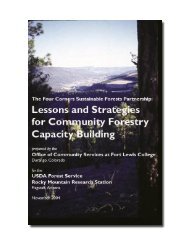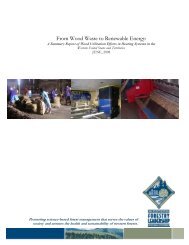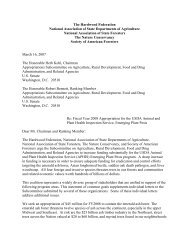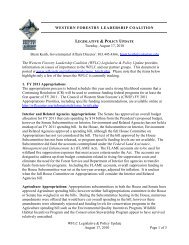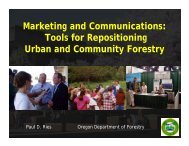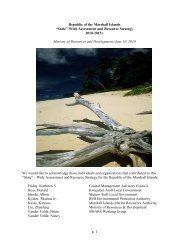Emission Controls for Small Wood-Fired Boilers - Western Forestry ...
Emission Controls for Small Wood-Fired Boilers - Western Forestry ...
Emission Controls for Small Wood-Fired Boilers - Western Forestry ...
Create successful ePaper yourself
Turn your PDF publications into a flip-book with our unique Google optimized e-Paper software.
2.0 SCOPE OF STUDY<br />
The scope of this study was to update and expand the RSG 2001 report as follows:<br />
1) Identify and Evaluate Best Management Practices (BMPs). BMPs, also called “work practice<br />
standards” and “inherently lower emitting processes and practices,” are used to control<br />
emissions upstream of add‐on control technologies such as mechanical collectors (cyclones,<br />
multicyclones), baghouses (fabric filters), electrostatic precipitators (ESPs), etc. Attention is<br />
typically directed toward add‐on emission control selection. These solutions are typically more<br />
costly. While not as effective as most add‐on controls, BMPs can substantially reduce emissions,<br />
improve system efficiency and improve system per<strong>for</strong>mance; there<strong>for</strong>e, this report will focus on<br />
BMPs in addition to add‐on controls. This said, BMPs alone will not likely satisfy the<br />
requirements <strong>for</strong> “LAER” or lowest achievable emission rate, which is typically required in nonattainment<br />
areas. Non‐attainment areas are areas where one or more of the National Ambient<br />
Air Quality Standards (NAAQS) are not met.<br />
2) Expand the original size range evaluated from 3 MMBtu/hr 10 MMBtu/hr to 3 MM Btu/hr<br />
30 MM Btu/hr (heat input). 1 This report will still focus on small (less than 10 MMBtu/hr)<br />
wood boilers. However, there is new in<strong>for</strong>mation available from recently constructed wood<br />
boilers smaller than 3MMBtu/hr and larger than 10 MMBtu/hr that can be extrapolated to the 3<br />
to 10 MMBtu/hr size range. This in<strong>for</strong>mation was evaluated <strong>for</strong> the purposes of this report.<br />
3) Include emissions control in<strong>for</strong>mation <strong>for</strong> PM2.5 and a number of hazardous air<br />
pollutants (HAPs) including Mercury. This is primarily in response to EPA’s strengthening of<br />
the PM2.5 NAAQS and due to recent availability of stack emission test data <strong>for</strong> PM2.5 and HAPs.<br />
4) Include pellet boiler emission in<strong>for</strong>mation. Many new pellet boilers and pellet production<br />
plants (pellet mills) have been constructed in recent years in response to demand <strong>for</strong> this fuel. In<br />
addition, a number of stack emission tests have been completed <strong>for</strong> pellet boilers in the United<br />
States. This report will discuss this new in<strong>for</strong>mation.<br />
3.0 EMISSIONS OVERVIEW<br />
When evaluating emission controls <strong>for</strong> biomass boilers, it is important to first develop an understanding<br />
of current actual emissions from biomass boilers. The most current and descriptive emissions<br />
in<strong>for</strong>mation is obtained from exhaust stack emission tests per<strong>for</strong>med according to EPA reference<br />
methods. These tests are typically per<strong>for</strong>med to fulfill air pollution control permit requirements<br />
requiring a demonstration that emission limits are being met. In addition to compliance emission tests,<br />
many voluntary tests have been sponsored by interested parties given the level of interest in knowing<br />
actual emissions and effectiveness of emission controls. These tests were completed throughout the<br />
United States, with different fuel characteristics, different firing rates and different emission controls.<br />
This study focused on particulate matter emissions. There are many terms used to characterize<br />
particulate matter. For the purposes of this report, the term particulate matter includes all sizes of solid<br />
particles and liquid particles (droplets). Solid particles are referred to as “filterable” particulate matter<br />
because they can be measured with a filter. Liquid particles are also called “condensable” particulate<br />
1<br />
30 MMBtu/hr is the threshold level at which the federal PM emission limit drops to 0.030 lb/MMBtu. This emission limit cannot be<br />
achieved with a mechanical collector. See 40 CFR Part 60, Subpart Dc. – Standards of Per<strong>for</strong>mance <strong>for</strong> <strong>Small</strong> Industrial‐Commercial‐<br />
Institutional Steam Generating Units.<br />
Resource Systems Group, Inc.<br />
<strong>Emission</strong> Control Technologies <strong>for</strong> <strong>Small</strong> <strong>Wood</strong>‐<strong>Fired</strong> <strong>Boilers</strong><br />
6 May 2010 Page 3



